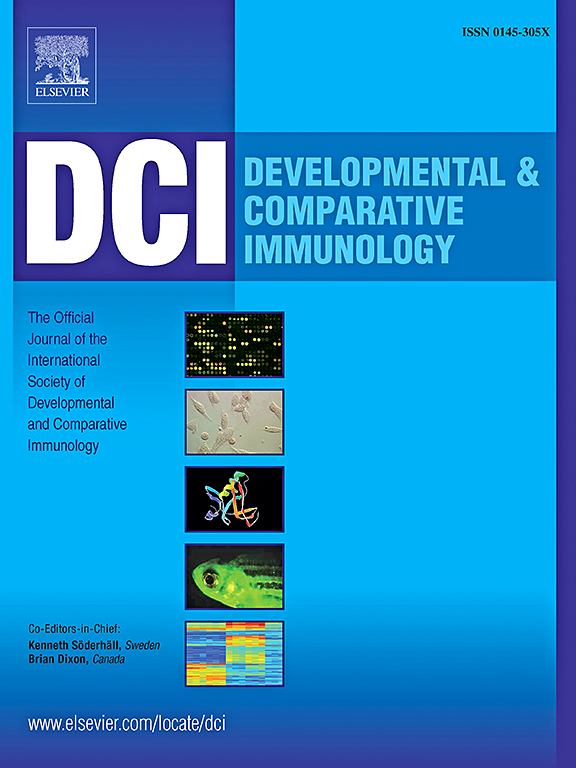Identification of scavenger receptor (LmSRA3) gene and its immune response to Aeromonas veronii in Lateolabrax maculatus
IF 2.7
3区 农林科学
Q1 FISHERIES
引用次数: 0
Abstract
Scavenger receptors (SRs) serve as essential pattern recognition receptors in the innate immune system, playing multiple roles in the immunity of fish. They contribute to defense mechanisms against pathogenic infections through various pathways. However, research on the functions of SRs in the immune response of Spotted sea bass remains limited. Here, the LmSRA3 gene was cloned and identified from Spotted sea bass, and a bioinformatic analysis of the sequence was conducted. This analysis revealed that the open reading frame of LmSRA3 spans 1821 bp and encodes 606 amino acids. The estimated molecular mass of this protein is 66.62 kDa, accompanied by isoelectric point of 6.06. It contains a collagen domain, a low-complexity structure, and two coiled-coils regions. Multiple sequence comparisons and phylogenetic analyses demonstrated that the LmSRA3 sequence is notably conserved among fish species. Furthermore, qPCR analysis showed that the LmSRA3 gene is expressed in all examined tissues, with the highest expression in the intestine. In the head kidney, spleen, blood, and intestine after infection with A. veronii, the expression levels of the LmSRA3 gene generally exhibited a pattern of first increasing followed by decreasing, suggesting that LmSRA3 may be involved in the immune response to A. veronii infection through multiple pathways. Subcellular localization experiments revealed that LmSRA3 is predominantly distributed in the cytoplasm. Additionally, results from the enzyme-linked immunosorbent assay indicated the binding capacity of LmSRA3 to A. veronii is not significant. Furthermore, interference or overexpression of LmSRA3 significantly affected the expression of RelA, MyD88, TNFR1, and IL-1β. These results emphasize that LmSRA3 may play a crucial role in the innate immune response of Spotted sea bass and provides insights into the mechanism by which SRs are in the antibacterial immunity of this species.
黄斑鱼清道夫受体(LmSRA3)基因的鉴定及其对维罗氏气单胞菌的免疫应答。
清道夫受体(Scavenger receptor, SRs)是先天免疫系统中必不可少的模式识别受体,在鱼类免疫系统中发挥着多种作用。它们通过各种途径促进防御机制抵御致病性感染。然而,关于SRs在黑鲈免疫应答中的作用的研究仍然有限。本研究从斑点海鲈中克隆并鉴定了LmSRA3基因,并对其序列进行了生物信息学分析。结果表明,LmSRA3的开放阅读框长度为1821 bp,编码606个氨基酸。该蛋白的分子量为66.62 kDa,等电点为6.06。它包含一个胶原结构域,一个低复杂性的结构,和两个卷曲的线圈区域。多个序列比较和系统发育分析表明,LmSRA3序列在鱼类中具有明显的保守性。此外,qPCR分析显示LmSRA3基因在所有检测组织中均有表达,其中在肠中的表达量最高。在veronii感染后的头部肾脏、脾脏、血液和肠道中,LmSRA3基因的表达水平普遍呈现先升高后降低的模式,提示LmSRA3可能通过多种途径参与对veronii感染的免疫应答。亚细胞定位实验显示LmSRA3主要分布在细胞质中。此外,酶联免疫吸附试验结果表明,LmSRA3与维氏弧菌的结合能力不显著。此外,干扰或过表达LmSRA3显著影响RelA、MyD88、TNFR1和IL-1β的表达。这些结果强调LmSRA3可能在斑点海鲈的先天免疫应答中发挥重要作用,并为SRs在该物种抗菌免疫中的作用机制提供了新的见解。
本文章由计算机程序翻译,如有差异,请以英文原文为准。
求助全文
约1分钟内获得全文
求助全文
来源期刊
CiteScore
6.20
自引率
6.90%
发文量
206
审稿时长
49 days
期刊介绍:
Developmental and Comparative Immunology (DCI) is an international journal that publishes articles describing original research in all areas of immunology, including comparative aspects of immunity and the evolution and development of the immune system. Manuscripts describing studies of immune systems in both vertebrates and invertebrates are welcome. All levels of immunological investigations are appropriate: organismal, cellular, biochemical and molecular genetics, extending to such fields as aging of the immune system, interaction between the immune and neuroendocrine system and intestinal immunity.

 求助内容:
求助内容: 应助结果提醒方式:
应助结果提醒方式:


